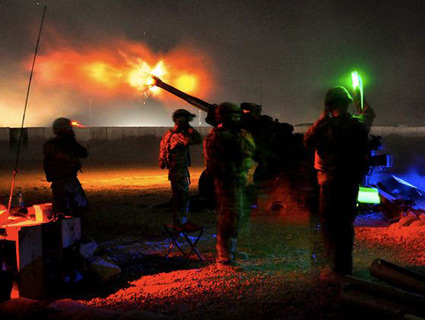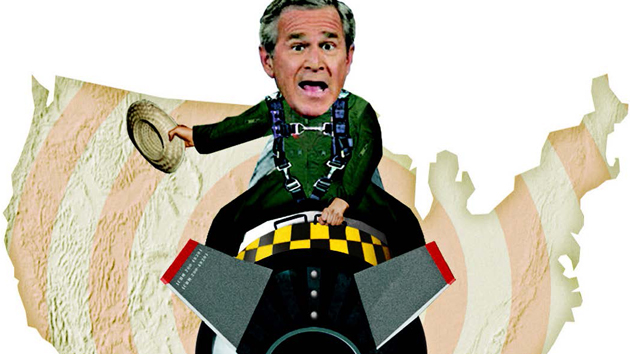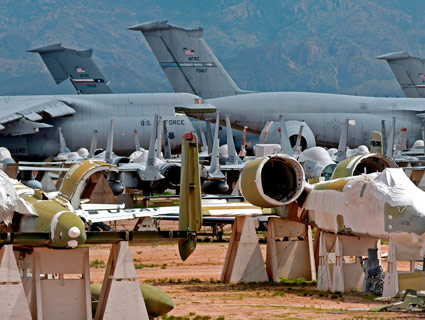
Soldiers fire illumination at suspected enemy movements in Afghanistan's Zabul province.<a href="http://www.flickr.com/photos/soldiersmediacenter/5963358453/">US Army</a>/Flickr
This story first appeared on the TomDispatch website.
With the United States now well into the second decade of what the Pentagon has styled an “era of persistent conflict,” the war formerly known as the global war on terrorism (unofficial acronym WFKATGWOT) appears increasingly fragmented and diffuse. Without achieving victory, yet unwilling to acknowledge failure, the United States military has withdrawn from Iraq. It is trying to leave Afghanistan, where events seem equally unlikely to yield a happy outcome.
![]() Elsewhere—in Pakistan, Libya, Yemen, and Somalia, for example— US forces are busily opening up new fronts. Published reports that the United States is establishing “a constellation of secret drone bases” in or near the Horn of Africa and the Arabian Peninsula suggest that the scope of operations will only widen further. In a front-page story, the New York Times described plans for “thickening” the global presence of US special operations forces. Rushed Navy plans to convert an aging amphibious landing ship into an “afloat forward staging base”—a mobile launch platform for either commando raids or minesweeping operations in the Persian Gulf—only reinforces the point. Yet as some fronts close down and others open up, the war’s narrative has become increasingly difficult to discern. How much farther until we reach the WFKATGWOT’s equivalent of Berlin? What exactly is the WFKATGWOT’s equivalent of Berlin? In fact, is there a storyline here at all?
Elsewhere—in Pakistan, Libya, Yemen, and Somalia, for example— US forces are busily opening up new fronts. Published reports that the United States is establishing “a constellation of secret drone bases” in or near the Horn of Africa and the Arabian Peninsula suggest that the scope of operations will only widen further. In a front-page story, the New York Times described plans for “thickening” the global presence of US special operations forces. Rushed Navy plans to convert an aging amphibious landing ship into an “afloat forward staging base”—a mobile launch platform for either commando raids or minesweeping operations in the Persian Gulf—only reinforces the point. Yet as some fronts close down and others open up, the war’s narrative has become increasingly difficult to discern. How much farther until we reach the WFKATGWOT’s equivalent of Berlin? What exactly is the WFKATGWOT’s equivalent of Berlin? In fact, is there a storyline here at all?
Viewed close-up, the “war” appears to have lost form and shape. Yet by taking a couple of steps back, important patterns begin to appear. What follows is a preliminary attempt to score the WFKATGWOT, dividing the conflict into a bout of three rounds. Although there may be several additional rounds still to come, here’s what we’ve suffered through thus far.
The Rumsfeld Era
Round 1: Liberation. More than any other figure—more than any general, even more than the president himself—Secretary of Defense Donald Rumsfeld dominated the war’s early stages. Appearing for a time to be a larger-than-life figure—the “Secretary at War” in the eyes of an adoring (if fickle) neocon fan club—Rumsfeld dedicated himself to the proposition that, in battle, speed holds the key to victory. He threw his considerable weight behind a high-tech American version of blitzkrieg. US forces, he regularly insisted, were smarter and more agile than any adversary. To employ them in ways that took advantage of those qualities was to guarantee victory. The journalistic term adopted to describe this concept was “shock and awe.”
No one believed more passionately in “shock and awe” than Rumsfeld himself. The design of Operation Enduring Freedom, launched in October 2001, and of Operation Iraqi Freedom, begun in March 2003, reflected this belief. In each instance, the campaign got off to a promising start, with US troops landing some swift and impressive blows. In neither case, however, were they able to finish off their opponent or even, in reality, sort out just who their opponent might be. Unfortunately for Rumsfeld, the “terrorists” refused to play by his rulebook and US forces proved to be less smart and agile than their technological edge—and their public relations machine—suggested would be the case. Indeed, when harassed by minor insurgencies and scattered bands of jihadis, they proved surprisingly slow to figure out what hit them.
 In Afghanistan, Rumsfeld let victory slip through his grasp. In Iraq, his mismanagement of the campaign brought the United States face-to-face with outright defeat. Rumsfeld’s boss had hoped to liberate (and, of course, dominate) the Islamic world through a series of short, quick thrusts. What Bush got instead were two different versions of a long, hard slog. By the end of 2006, “shock and awe” was kaput. Trailing well behind the rest of the country and its armed forces, the president eventually lost confidence in his defense secretary’s approach. As a result, Rumsfeld lost his job. Round one came to an end, the Americans, rather embarrassingly, having lost it on points.
In Afghanistan, Rumsfeld let victory slip through his grasp. In Iraq, his mismanagement of the campaign brought the United States face-to-face with outright defeat. Rumsfeld’s boss had hoped to liberate (and, of course, dominate) the Islamic world through a series of short, quick thrusts. What Bush got instead were two different versions of a long, hard slog. By the end of 2006, “shock and awe” was kaput. Trailing well behind the rest of the country and its armed forces, the president eventually lost confidence in his defense secretary’s approach. As a result, Rumsfeld lost his job. Round one came to an end, the Americans, rather embarrassingly, having lost it on points.
The Petraeus Era
Round 2: Pacification. Enter General David Petraeus. More than any other figure, in or out of uniform, Petraeus dominated the WFKATGWOT’s second phase. Round two opened with lowered expectations. Gone was the heady talk of liberation. Gone, too, were predictions of lightning victories. The United States was now willing to settle for much less while still claiming success.
Petraeus offered a formula for restoring a semblance of order to countries reduced to chaos as a result of round one. Order might permit the United States to extricate itself while maintaining some semblance of having met its policy objectives. This became the operative definition of victory.
The formal name for the formula that Petraeus devised was counterinsurgency, or COIN. Rather than trying to defeat the enemy, COIN sought to facilitate the emergence of a viable and stable nation-state. This was the stated aim of the “surge” in Iraq ordered by President George W. Bush at the end of 2006.
With Petraeus presiding, violence in that country did decline precipitously. Whether the relationship was causal or coincidental remains the subject of controversy. Still, Petraeus’s apparent success persuaded some observers that counterinsurgency on a global scale—GCOIN, they called it—should now form the basis for US national security strategy. Here, they argued, was an approach that could definitively extract the United States from the WFKATGWOT, while offering victory of a sort. Rather than employing “shock and awe” to liberate the Islamic world, US forces would apply counterinsurgency doctrine to pacify it.
The task of demonstrating the validity of COIN beyond Iraq fell to General Stanley McChrystal, appointed with much fanfare in 2009 to command US and NATO forces in Afghanistan. Press reports celebrated McChrystal as another Petraeus, the ideal candidate to replicate the achievements already credited to “King David.”
McChrystal’s ascendency came at a moment when a cult of generalship gripped Washington. Rather than technology being the determinant of success as Rumsfeld had believed, the key was to put the right guy in charge and then let him run with things. Political figures on both sides of the aisle fell all over themselves declaring McChrystal the right guy for Afghanistan. Pundits of all stripes joined the chorus.
Once installed in Kabul, the general surveyed the situation and, to no one’s surprise, announced that “success demands a comprehensive counterinsurgency campaign.” Implementing that campaign would necessitate an Afghan “surge” mirroring the one that had seemingly turned Iraq around. In December 2009, albeit with little evident enthusiasm, President Barack Obama acceded to his commander’s request (or ultimatum). The US troop commitment to Afghanistan rapidly increased.
Here things began to come undone. Progress toward reducing the insurgency or improving the capacity of Afghan security forces was—by even the most generous evaluation—negligible. McChrystal made promises—like meeting basic Afghan needs with “government in a box, ready to roll in”—that he proved utterly incapable of keeping. Relations with the government of President Hamid Karzai remained strained. Those with neighboring Pakistan, not good to begin with, only worsened. Both governments expressed deep resentment at what they viewed as high-handed American behavior that killed or maimed noncombatants with disturbing frequency.
To make matters worse, despite all the hype, McChrystal turned out to be miscast—manifestly the wrong guy for the job. Notably, he proved unable to grasp the need for projecting even some pretence of respect for the principle of civilian control back in Washington. By the summer of 2010, he was out—and Petraeus was back in.
In Washington (if not in Kabul), Petraeus’s oversized reputation quelled the sense that with McChrystal’s flame-out Afghanistan might be a lost cause. Surely, the most celebrated soldier of his generation would repeat his Iraq magic, affirming his own greatness and the continued viability of COIN.
Alas, this was not to be. Conditions in Afghanistan during Petraeus’s tenure in command improved—if that’s even the word—only modestly. The ongoing war met just about anyone’s definition of a quagmire. With considerable understatement, a 2011 National Intelligence Estimate called it a “stalemate.” Soon, talk of a “comprehensive counterinsurgency” faded. With the bar defining success slipping ever lower, passing off the fight to Afghan security forces and hightailing it for home became the publicly announced war aim.
That job remained unfinished when Petraeus himself headed for home, leaving the army to become CIA director. Although Petraeus was still held in high esteem, his departure from active duty left the cult of generalship looking more than a little the worse for wear. By the time General John Allen succeeded Petraeus—thereby became the eighth US officer appointed to preside over the ongoing Afghan War—no one believed that simply putting the right guy in charge was going to produce magic. On that inclusive note, round two of the WFKATGWOT ended.
The Vickers Era
Round 3: Assassination. Unlike Donald Rumsfeld or David Petraeus, Michael Vickers has not achieved celebrity status. Yet more than anyone else in or out of uniform, Vickers, who carries the title Under Secretary of Defense for Intelligence, deserves recognition as the emblematic figure of the WFKATGWOT’s round three. His low-key, low-profile persona meshes perfectly with this latest evolution in the war’s character. Few people outside of Washington know who he is, which is fitting indeed since he presides over a war that few people outside of Washington are paying much attention to any longer.
With the retirement of Secretary of Defense Robert Gates, Vickers is the senior remaining holdover from George W. Bush’s Pentagon. His background is nothing if not eclectic. He previously served in US Army Special Forces and as a CIA operative. In that guise, he played a leading role in supporting the Afghan mujahedeen in their war against Soviet occupiers in the 1980s. Subsequently, he worked in a Washington think tank and earned a PhD in strategic studies at Johns Hopkins University (dissertation title: “The Structure of Military Revolutions”).
Even during the Bush era, Vickers never subscribed to expectations that the United States could liberate or pacify the Islamic world. His preferred approach to the WFKATGWOT has been simplicity itself. “I just want to kill those guys,” he says—”those guys” referring to members of al-Qaeda. Kill the people who want to kill Americans and don’t stop until they are all dead: this defines the Vickers strategy, which over the course of the Obama presidency has supplanted COIN as the latest variant of US strategy.
The Vickers approach means acting aggressively to eliminate would-be killers wherever they might be found, employing whatever means are necessary. Vickers “tends to think like a gangster,” one admirer comments. “He can understand trends then change the rules of the game so they are advantageous for your side.”
Round three of the WFKATGWOT is all about bending, breaking, and reinventing rules in ways thought to be advantageous to the United States. Much as COIN supplanted “shock and awe,” a broad-gauged program of targeted assassination has now displaced COIN as the prevailing expression of the American way of war.
The United States is finished with the business of sending large land armies to invade and occupy countries on the Eurasian mainland. Robert Gates, when still Secretary of Defense, made the definitive statement on that subject. The United States is now in the business of using missile-armed drones and special operations forces to eliminate anyone (not excluding US citizens) the president of the United States decides has become an intolerable annoyance. Under President Obama, such attacks have proliferated.
This is America’s new MO. Paraphrasing a warning issued by Secretary of State Hillary Clinton, a Washington Post dispatch succinctly summarized what it implied: “The United States reserved the right to attack anyone who it determined posed a direct threat to US national security, anywhere in the world.”
Furthermore, acting on behalf of the United States, the president exercises this supposed right without warning, without regard to claims of national sovereignty, without Congressional authorization, and without consulting anyone other than Michael Vickers and a few other members of the national security apparatus. The role allotted to the American people is to applaud, if and when notified that a successful assassination has occurred. And applaud we do, for example, when a daring raid by members in SEAL Team Six secretly enter Pakistan to dispatch Osama bin Laden with two neatly placed kill shots. Vengeance long deferred making it unnecessary to consider what second-order political complications might ensue.
How round three will end is difficult to forecast. The best we can say is that it’s unlikely to end anytime soon or particularly well. As Israel has discovered, once targeted assassination becomes your policy, the list of targets has a way of growing ever longer.
So what tentative judgments can we offer regarding the ongoing WFKATGWOT? Operationally, a war launched by the conventionally minded has progressively fallen under the purview of those who inhabit what Dick Cheney once called “the dark side,” with implications that few seem willing to explore. Strategically, a war informed at the outset by utopian expectations continues today with no concretely stated expectations whatsoever, the forward momentum of events displacing serious consideration of purpose. Politically, a war that once occupied center stage in national politics has now slipped to the periphery, the American people moving on to other concerns and entertainments, with legal and moral questions raised by the war left dangling in midair.
Is this progress?
Andrew J. Bacevich is professor of history and international relations at Boston University. A TomDispatch regular, he is the author most recently of Washington Rules: The American Path to Permanent War and the editor of the new book The Short American Century: A Postmortem, just out from Harvard University Press. To catch Timothy MacBain’s latest Tomcast audio interview in which Bacevich discusses the changing face of the Gobal War on Terror, click here, or download it to your iPod here. Follow TomDispatch on Twitter @TomDispatch and join us on Facebook. To stay on top of important articles like these, sign up to receive the latest updates from TomDispatch.com here.














